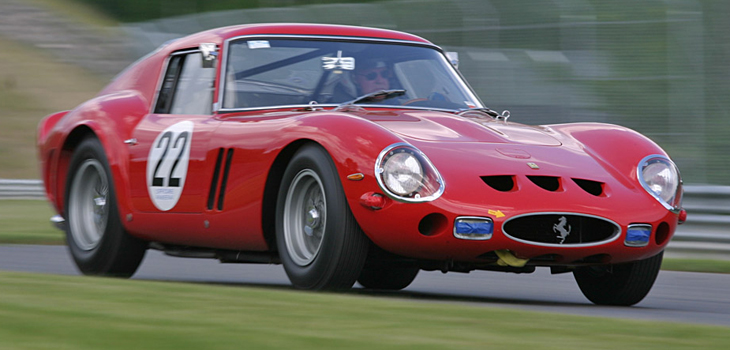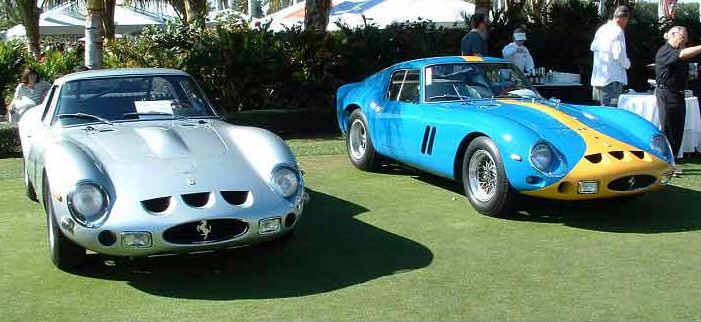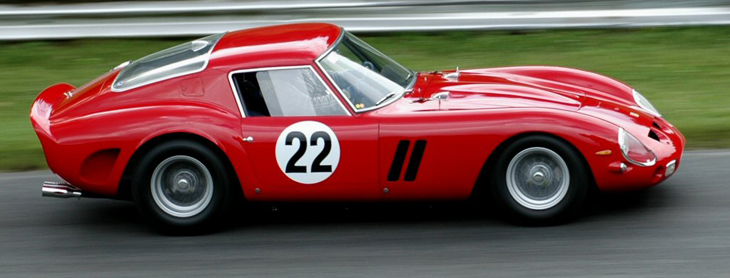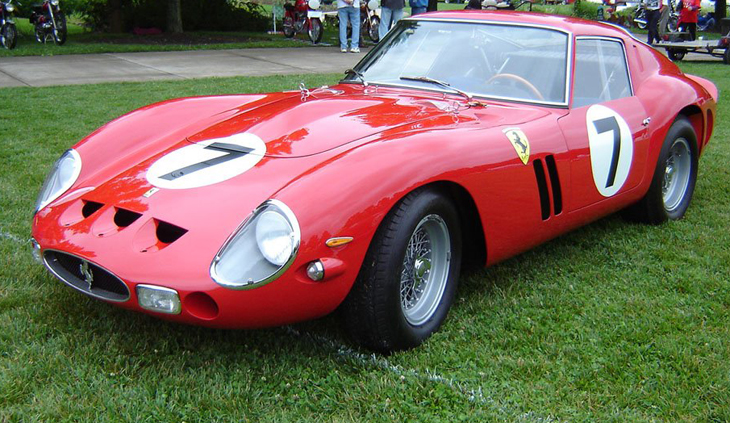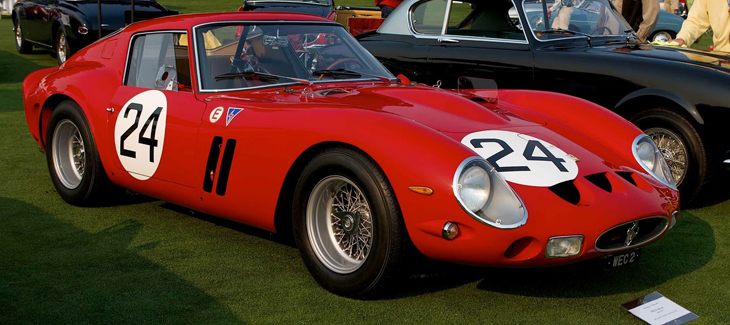|
This model had no tail spoiler, but one was added before its competition debut at the Sebring circuit in America in March 1962. On its maiden outing in the 12 Hour Race, driven by Phil Hill and Olivier Gendebien,
the 250 GTO finished second overall to a Ferrari 250 Testa Rossa sports racing car. It also won the GT category comfortably, an impressive debut performance upon which it would build during the next three years.
The
model was built on a 2400 mm wheel base, as had been the 250 GT 'SWB' from which it was derived. Although the chassis was built along the same lines, it used smaller section tubing, with additional bracing for increased
torsional rigidity, and was given factory type reference 539/62 Comp., and then 539/64 Comp. Like the earlier 250 GT 'SWB' Berlinettas, four wheel disc brakes were fitted, with a cable-operated handbrake to the rear wheels, and
it was also available as both a left- and right-hand drive.
Early development of the new model was shrouded in secrecy, with Giotto Bizzarrini charged with developing a car to take on and beat the Jaguar E Type. In
various interviews over the years he has said he was given an old 250 GT Boano chassis as a basis for the project. However, internal factory records show that he was provided with a 250 GT 'passo corto' (chassis 1791GT) on
which to base the new car. On its first outing at Monza in September 1961, prior to the Italian Grand Prix, the 250 GTO earned the nickname 'Il Mostro' (The Monster), due to its rough-hewn and ill fitting prototype body. During
test sessions, Stirling Moss drove the car to record times far better than those ever achieved by a 250 GT 'passo corto'. A 'palace revolution' followed later in the year, and Bizzarrini found himself on the outside, with
refinement of the GTO body entrusted to Sergio Scaglietti, who created its definitive shape.
The power unit was essentially a 250 Testa Rossa specification version of the Colombo single overhead camshaft per bank 3-litre
V12 engine, with bore and stroke of 73 x 58.8 mm, but using dry sump lubrication, with factory type reference 168 Comp/62. The spark plugs were outside the vee of the block, and there was a bank of six twin choke Weber 38 DCN
carburettors, with a twin coil and rear of engine mounted distributor ignition system, to produce a claimed 300 bhp. The engine was coupled to a new 5-speed, all synchromesh gearbox, with an open gate gear-change tower in the
cockpit, similar to that used on the sports racing models since the mid-fifties, driving through a propeller shaft to the rigid rear axle, fitted with a Watts linkage. As befitted its intended competition use, a wide range of
rear axle ratios was available.
The overall shape of the aluminium bodies designed and built by Scaglietti changed very little during the production period from 1962 to 1964, apart from a one-off example bodied in the
style of the 330 LM Berlinetta. The last three cars in the series received Pininfarina-designed and Scaglietti-built bodies of a style very similar to that used on the mid-engine 250 LM sports racing car. Four earlier cars were
also re-bodied in the later style during 1964. Although the overall body shape didn't alter to any great degree, the detail differences during the production run certainly did. The early cars in the series had a small
elliptical radiator opening, bounded by rectangular driving lights, initially with brake cooling ducts under the nose, which then changed to vertical brake cooling slots in the nose alongside the driving lights, with the
sidelights mounted below the Plexiglass shrouded headlights. The rear spoiler was bolted to the tail panel, and there were cabin exhaust air slots in the sail panels. The brake cooling ducts soon became circular, and the side
lights moved to a semi-recessed location in the wing sides; a little while after these modifications the tail spoiler, still of the same profile, became an integral, riveted part of the body construction.
All of the
examples produced, apart from the '64-bodied cars, had three removable 'D'-shaped panels, retained by quarter turn fasteners, on the upper face of the nose, for increased radiator air throughput, the pattern being repeated with
three similar uncovered openings in the underside of the nose panel. The '64-bodied cars and re-bodies again have detail differences between individual cars, but these relate more to the roof shape, which was either long, short
with integral spoiler, or short without spoiler and the bonnet, which either had a long slim bulge tapering into the nose panel or a cold air intake. A number of cars were modified during their competition careers, notably with
the addition of a third front wing exhaust air slot, and occasionally louvres were added to the bonnet to aid heat dissipation. Apart from these main points, there were numerous individual differences between the various cars,
i.e. some had the rear lights mounted on raised 'bridges', while others had them fixed directly to the tail panel.
The 250 GTO Berlinettas continued the run of successes of the preceding 'passo lungo' and 'passo corto'
models, and with the manufacturers' championship being transferred to the GT category from 1962, gave Ferrari a hat trick of victories between 1962 and 1964. They were virtually dominant in their class, and were only being
caught by the AC Cobras (with much larger capacity V8 engines) during their last competitive year. Amongst the numerous international successes of the 250 GTO were wins in the Tour de France in 1963 and 1964; GT class wins in
the Targa Florio in 1962, 1963 and 1964; victories in the Tourist Trophy at Goodwood in 1962 and 1963; with GT category wins at Le Mans in 1962 and 1963, and in the Nurburgring 1000 km in 1963 and 1964.
The 250 GTO was
the ultimate expression of the Ferrari 250 GT car. It was equally at home on the road or track – perhaps the last dual purpose road/race car produced – and has achieved legendary status amongst aficionados of the marque. With
only a relatively small production run of thirty-six cars, and with many of the examples produced having a great race pedigree, it has become one of the icons of Ferrari production history, with a revered position in
collector's circles.
Engine
- Type front, longitudinal 60° V12
- Bore/stroke 73 x 58.8 mm
- Unitary displacement 246.10 cc
- Total displacement 2953.21 cc
- Compression ratio 9.8 : 1
- Maximum power 221 kW (300 hp) at 7400 rpm
- Power per litre 102 hp/l
- Valve actuation single overhead camshafts per bank, two valves per cylinder
- Fuel feed six Weber 38 DCN carburettors
- Ignition single spark plug per cylinder, two coils
- Lubrication dry sump
- Clutch single-plate
|



